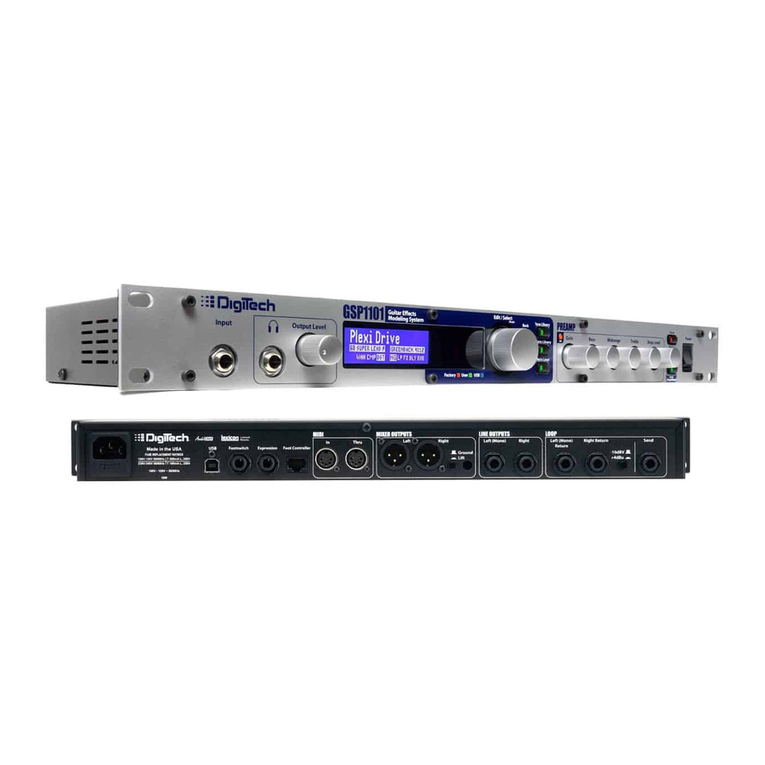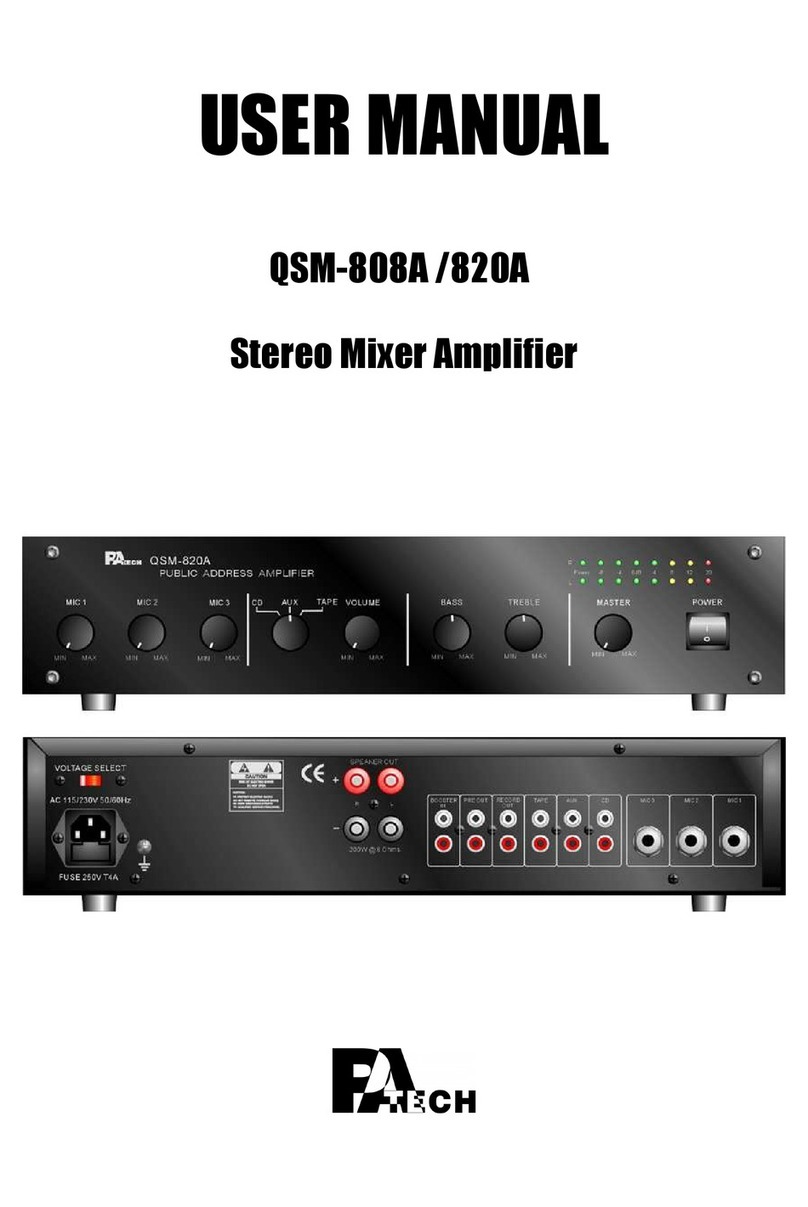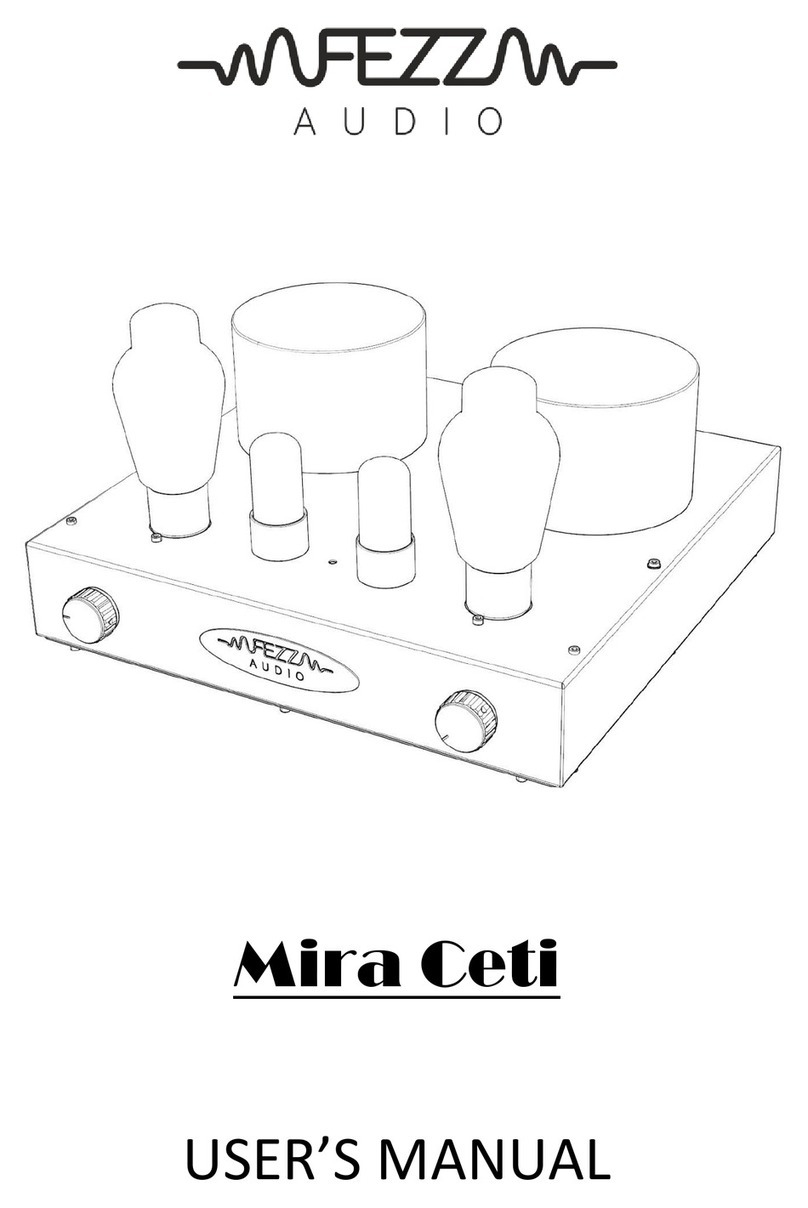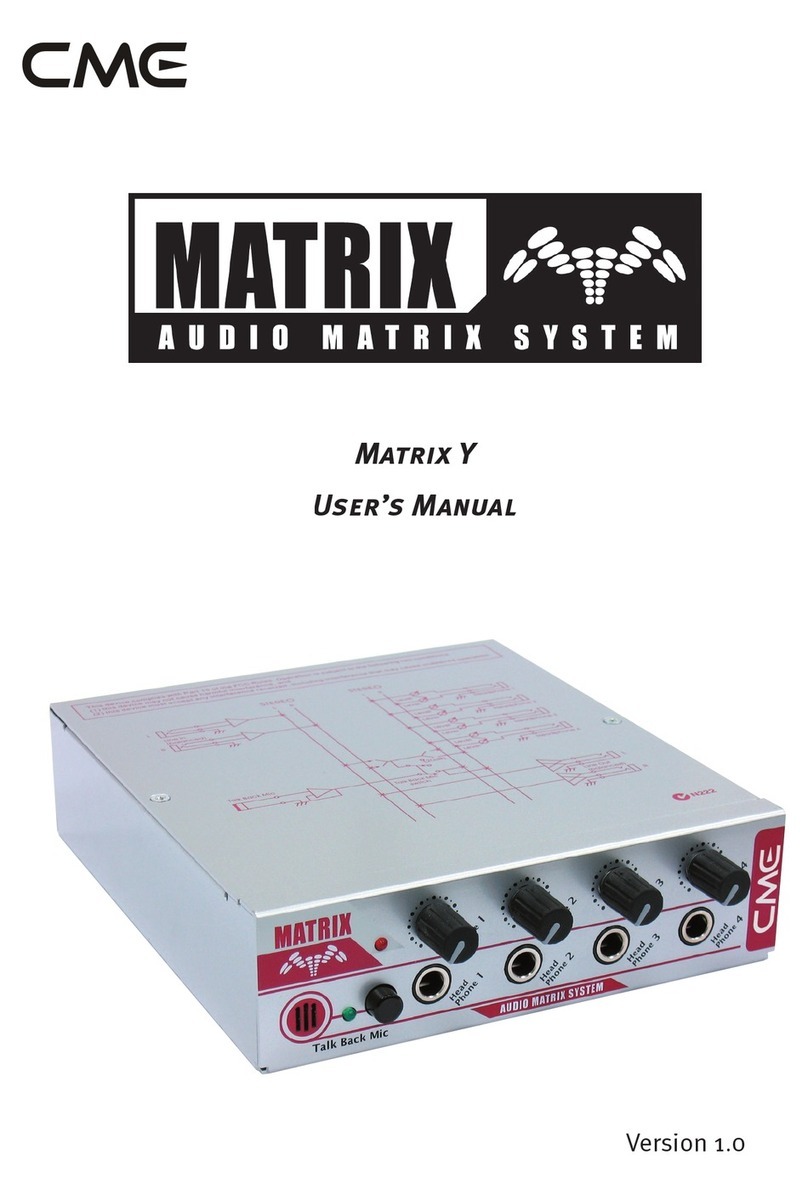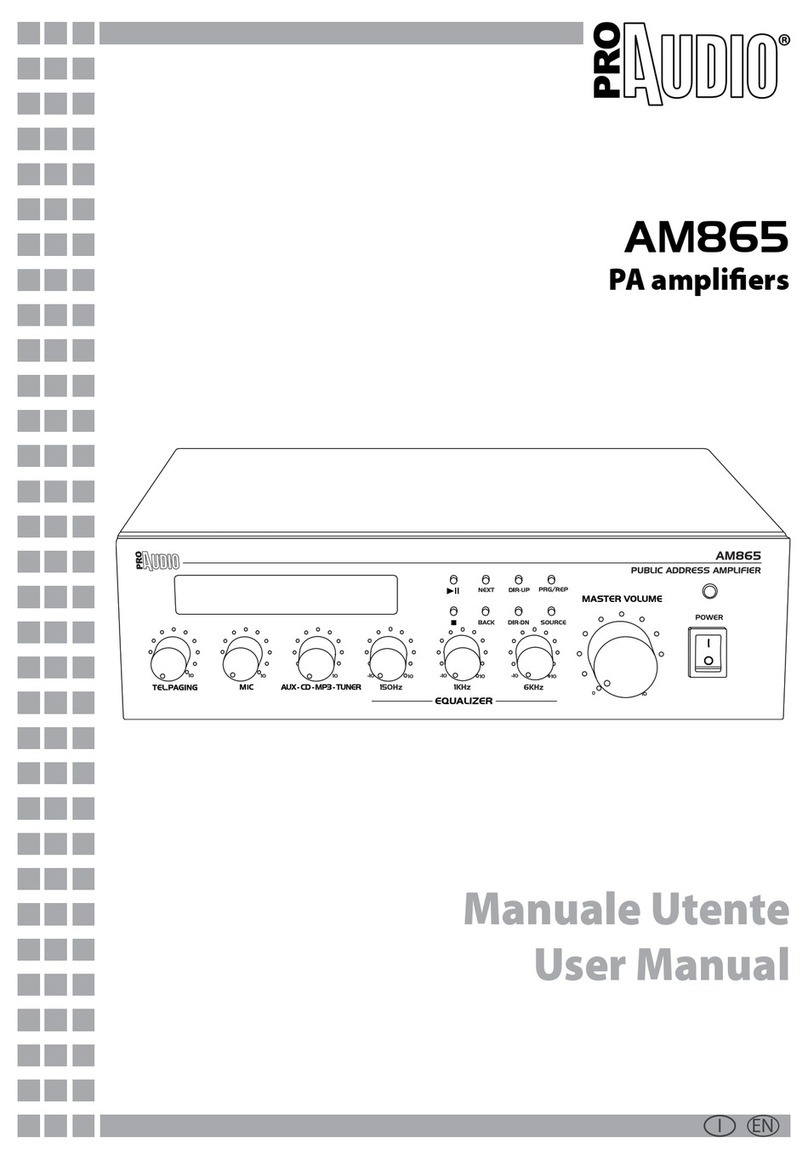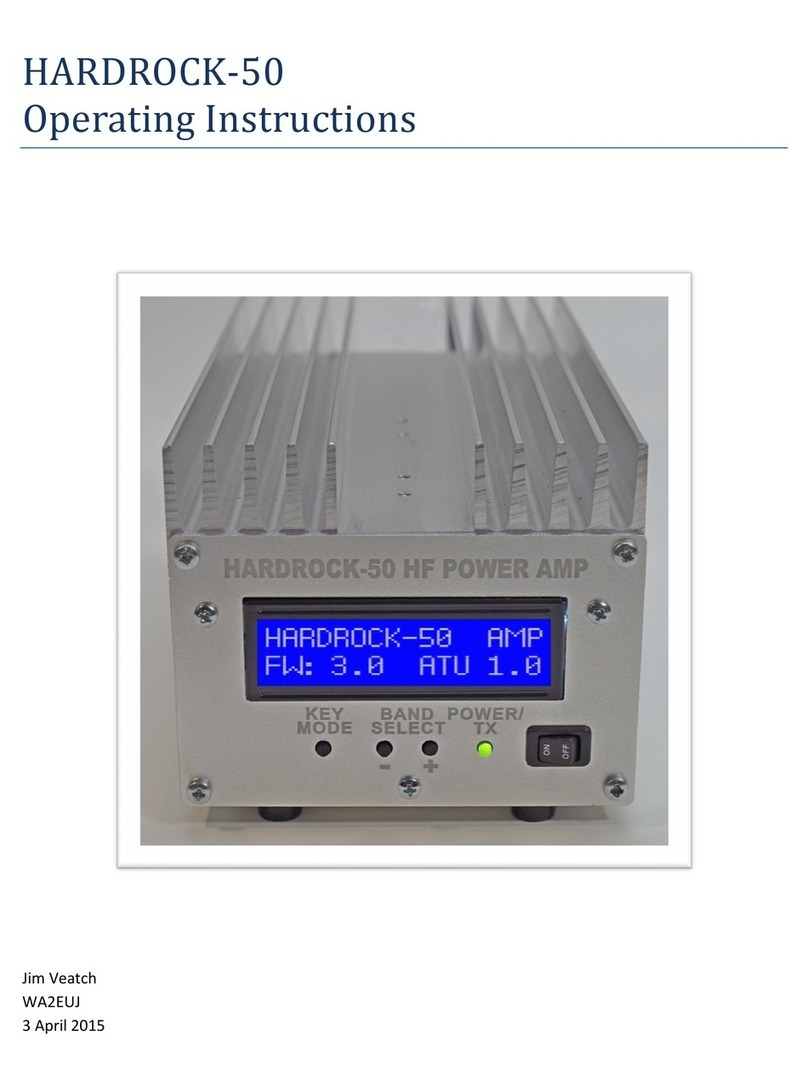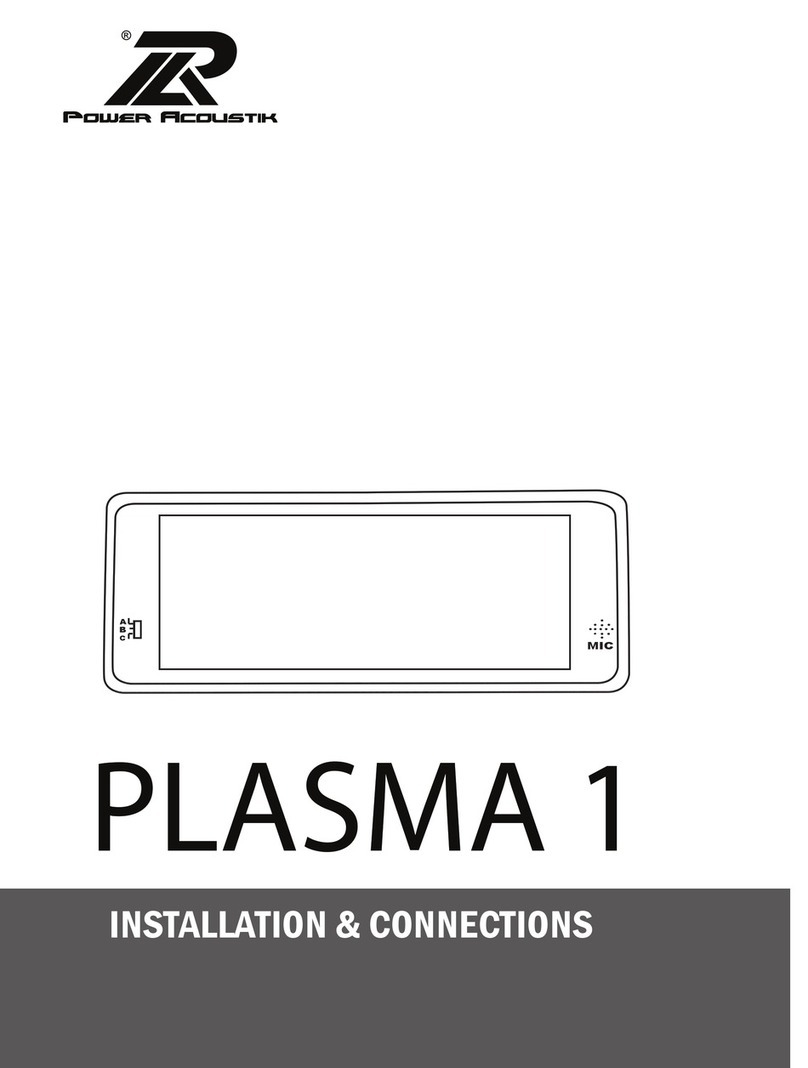FiveFish Studios SC-1mk500 Mic Preamp Kit User manual

SC-1mk500 Mic Preamp Kit
Solid State, DC-Servo, Balanced Mic Preamplifier
with Input Transformer Option
Simplicity Counts, Detail Matters.
No part of this document may be reproduced, either mechanically or electronically, posted online on the Internet, in whole or in
part, without the expressed, written permission of FiveFish Studios. This document is solely provided
to the kit builder of the SC-1mk500 Mic Preamp Kit.
Copyright 2008 FiveFish Studios
www.fivefishstudios.com
Last Revision: November 29, 2008

Page 1
Copyright 2008 FiveFish Studios
www.fivefishstudios.com
SC-1mk500 Microphone Preamp Kit
SC-1mk500 Mic Preamp
Solid State, DC-Servo, Balanced Mic Preamplifier
with Input Transformer Option
Congratulations and thank you for your purchase of the SC-1mk500 Mic Preamp Kit.
This is the 2nd generation design of our popular SC-1 Mic Preamp Kit.
Hundreds of hours have been spent in the design, manufacturing and packaging of this kit to deliver to you a great preamp, with
the same features and performance found on some high-end boutique preamps. All at a very affordable price!
There are no special, expensive tools or techniques required to assemble this kit. All you need is the ability to follow
instructions, use common sense, and the confidence in knowing that YOU can do this.
PLEASE READ THIS DOCUMENT COMPLETELY BEFORE YOU ASSEMBLE YOUR PREAMP KIT.
I know people sometimes don’t want to read manuals. But unlike software, there is NO UNDO for this project. READ THIS
ASSEMBLY GUIDE COMPLETELY FIRST. Take your time, and ask questions if you are unsure of something. Work methodically
and carefully. I promise you, you’ll be rewarded with a great preamp when you’re finished. And you’ll have pride and joy when
you tell others that “Yes, I built this!”
Prior Kit Building Experience is HIGHLY recommended for this project.
Features, Advantages and Benefits of the SC-1mk500 Mic Preamp
-NEW: 500 series card format, compatible with API rack system
-NEW: Option to use input transformer for added sound “flavor”
-NEW: Gain range from +12 to +72dB, in 6dB increments from +12db to +42dB; 4dB increments from 46dB to 72dB.
-NEW: 5-LED VU Meter
-Low-Noise, High-Quality Mic Preamp
-All solid-state design, using chipsets from THAT Corp and Burr-Brown
-Soft-start, slow ramp-on +48V phantom power
-Crystal clear Red LED indicator for phantom power
-Electronically balanced input and output stages (option to use input transformer for transformer balancing)
-12-position Grayhill gain selector switch
-Input RFI protection

Page 2
Copyright 2008 FiveFish Studios
www.fivefishstudios.com
SC-1mk500 Microphone Preamp Kit
-Input clamping protection
-Output surge protection circuit
-Output RFI protection
-Reduced clicking and popping when changing gains
-High quality Bourns, sealed, conductive plastic potentiometer for volume control
-High quality PCB Mounted DPDT Switch
-Gold-plated, machined, low-profile IC sockets
-Use of high quality 1% Metal Film resistors, and high-quality ceramic and electrolytic capacitors
-On-board jumper terminals
-Easy to assemble, easy to troubleshoot design
-Each component carefully labeled, protected and packed in separate zip bags
-Thick PCB board with 2oz. copper
-Very affordable!!! No, this is not “cheap junk” but a high quality product that is reasonably affordable! (i.e. because
there is no middlemen, and we don’t do expensive glossy magazine advertising! )
Basic Tools Required
A few basic tools are required to build this kit.
1. Soldering iron – adjustable temperature recommended, but not necessary. Your soldering iron must have a sharp
conical tip. I do not recommend a “flat-head, screwdriver-type” soldering iron. DO NOT USE A SOLDERING GUN. They
are usually rated at 100Watts and are overkill for this project.
2. Mini Pliers Cutter – to cut component leads, wires, strip insulation off wires (if you don’t have a wire-stripper tool).
3. Mini Long Nose Pliers – to bend component leads, use as a heatsink, hold components, tighten bolts.
4. Manual Solder sucker pump or desoldering gun– sucks up solder when you made a mistake soldering components on
the PCB. Pictured below is a Hakko model.

Page 3
Copyright 2008 FiveFish Studios
www.fivefishstudios.com
SC-1mk500 Microphone Preamp Kit
5. Multitester – A simple meter/tester to measure resistance, and voltages. A digital read-out is a big help.
6. Soldering Lead – 60/40 lead or lead-free solder
7. Magnifying glass – to see what you’re doing! Especially when soldering IC pins and the Grayhill selector switch.
8. Clean and well-lighted work area – Lots of good lighting, clean work area. You want to be able to leave your work-in-
progress without packing everything away.
Extra Tools (Nice to have, but not required)
1. Vacuum desoldering pump – if you make a mistake, you need to pull out the component from the PCB
2. Component lead bender – bend component leads like resistors uniformly and evenly
3. PanaVise – to hold PCB while you’re working on it
4. Tweezers – to pick tiny things
5. Masking tape – to hold components on the PCB while working
6. Wire-stripper – for cutting wires and stripping its insulation

Page 4
Copyright 2008 FiveFish Studios
www.fivefishstudios.com
SC-1mk500 Microphone Preamp Kit
SC-1mk500 Parts Identification and Assembly Notes
For the newbies, this is not meant to be a full tutorial about electronics. But I want you to be able to identify components,
recognize them and know what their basic functionality is.
In these sections, you’d also find instructions on how to use the INSERT jacks, and other geeky stuff. You’d also learn why I
chose certain parts for this kit, even though they may be 3x more expensive than another equivalent part.
Resistors
All resistors used in the SC-1mk500 Kit are 1/4 watt resistors. Most, if not all, of them are 1%
tolerance, Metal-Film type resistors. These are high quality resistors, way way much better
than carbon composition type resistors (usually 10-20% tolerance).
Resistors provide resistance, and are measured in OHMS, the unit of resistance.
1,000 OHMS = 1 KOhms (pronounced KiloOhms, where kilo = 1,000)
If you see a resistor value marked “1K”, it means 1 KiloOhm. Sometimes, you would see values
written as 6K8, or 3K3.
6K8 is also the same as writing 6.8 Kohm. The decimal point position is implied by the “K”
letter.
3K3 is also the same as 3.3 KOhm, or 3,300 Ohms.
I don’t need to teach you how to read resistor color codes since all the SC-1MK500 parts are already labeled for you. But if
you’re curious on what those bands of wonderful technicolors mean, you can go here.
http://www.samengstrom.com/nxl/10116/5_band_resistor_color_code_page.en.html
Capacitors
There are many types of capacitors used in the SC-1mk500 Mic Preamp project. Some are big, some small, some are polarized,
some are non-polarized. We’ll discuss the different types here.
Ceramic Capacitors
Ceramic capacitors look like the picture on the left. On the SC-1mk500 kit, these are colored “yellow” and
“blue” and are very small in size. Ceramic capacitors are non-polarized, and therefore it does not matter
what orientation they go in. They can go in either way.
They are rated in microfarads
(abbreviated as “uf”). They also have
a voltage rating (abbreviated as “V”).
In a design, the voltage rating must not be exceeded.
Otherwise, you’ll ruin the capacitor. Either short it out, or
blow it open.
Capacitor parts are therefore rated with their capacitance
(in microfarads, uf) and voltage… specified like this:
0.1uf 100V
Capacitance values may be expressed in microfarads (uf),
nanofarad (nf) or picofarads (pf). The conversion between
these units are shown on the table above.
Electrolytic Capacitors
Electrolytic capacitors are cylindrical in construction. They look like the picture on the right. Unlike ceramic capacitors,
electrolytic capacitors USUALLY/MOSTLY have polarity. One side is marked with the (-) sign, also called the Cathode, or negative
side. The unmarked side is the (+) or Anode.
Just like ceramic capacitors, they are also measured in microfarads (uf). have a maximum voltage rating.
WARNING: It is VERY IMPORTANT not to insert Electrolytic capacitors backwards, or in the wrong polarity orientation. Doing so
may/will cause the capacitor to explode. Yes, you read that right… EXPLODE. Do not the let the small size of an electrolytic
capacitor fool you. Even a tiny electrolytic capacitor can explode with a lot of force.

Page 5
Copyright 2008 FiveFish Studios
www.fivefishstudios.com
SC-1mk500 Microphone Preamp Kit
All of the electrolytic capacitors used in the SC-1mk500 preamp have polarity, except the (2) blue electrolytic capacitors. 10uf
50V NP, shown on the picture on the right. These (2) electrolytic capacitors, labeled C12 and C13, are Non-Polarized, so it does
not matter how you insert them. But the rest of the capacitors in the SC-1mk500 kit should be inserted in the proper polarity.
Diodes
Diodes are semiconductor devices that permit current flow only in one direction. Think of it as a
one-way valve.
The SC-1mk500 preamp kit uses 3 different kinds of diodes.
1. The first type of diode we’re using is the ZENER DIODE. These zener diodes are used as
input protection to the mic preamp circuitry. You can find the zener diodes in the
locations shown on the photo to your right.
PLEASE NOTE: Even though the SC-1mk500 preamp uses input protection, please turn OFF
phantom power, and wait a few seconds (5-10 seconds) before unplugging your microphone.
Also, do not plug a mic while phantom power is ON. If you’re using the SC-1mk500 with TRS jacks connected to a patch
bay or another gear, do not turn ON phantom power… NEVER, EVER plug a jack into a patchbay with Phantom Power turned
ON. You risk of damaging any gear connected at the other end of the patch bay and may even possibly damage your
preamp. In short, turn OFF phantom power before connecting/disconnecting the microphone and/or jack. It takes only a
few seconds to do this. Don’t risk damaging your gear.
2. The second type of diode we’re using is the SIGNAL DIODE. They look almost exactly like
the Zener diodes. Nothing to worry about, I packed the Signal Diode in a separate Zip bag
for easy identification.
3. The third type of diode we use is the General Purpose, Rectifier Diode. They are black, with
a white/silver band.
NOTE: Diodes have polarities just like electrolytic capacitors. One side is
denoted as the ANODE (or positive side) and the other side is the
CATHODE (or negative side). If you soldered these diodes in the wrong
position, your phantom power or preamp may not work. Follow the band
markings on the PCB silkscreen layout.
Inductors
The SC-1mk500 Preamp kit also uses inductors for RFI protection in the output stage. Inductors have no polarities, and just like
resistors can be inserted in either orientation. The inductors we use look just like resistors. For your convenience, they are
packed in a separate zip bag and labeled.

Page 6
Copyright 2008 FiveFish Studios
www.fivefishstudios.com
SC-1mk500 Microphone Preamp Kit
Transistor
We’re using a transistor as a switching device in the SC-1mk500 Mic Preamp Kit. The transistor has (3) legs, the Collector, Base
and Emitter terminals. Looking from the top, the transistor has a half-circle shape, like a half-moon.
Take note when inserting transistors that you do not insert them backwards. Otherwise, phantom power will not work, and
possibly even ruin the transistor. The flat side should be facing to the right.
Grayhill Selector Switch
The SC-1mk500 uses a sealed, high-performance, high-quality, 12-position, Grayhill selector switch. This is one of the most
expensive items in this kit.
Some boutique preamp manufacturers also use Grayhill selector switches for their preamps. They are durable, reliable, have a
nice solid feel to it, and provide good resistance to RF Interference. This switch will be the most commonly used/abused
mechanical device on the SC-1mk500 preamp. I want this part to withstand being turned and turned and turned.
DPDT Switch (Dual Pole, Dual Throw.)
The SC-1mk500 also use a high quality, PCB mounted DPDT switch. This is another one of the expensive items in the kit. Again,
since this is a mechanical device, I want it to withstand repeated use of toggling on and off.
You need to toggle the switch to the leftmost position (pointing to the LED) to turn on phantom power. If you mount the SC-
1mk500 PCB vertically, the switch will be turned ON pointing upwards. If you mount the SC-1mk500 PCB horizontally, the
switch will be turned ON pointing left, towards the LED.
Bourns Sealed Potentiometer
This is another high-priced item in this kit because it is another mechanical component and I want this part to withstand the use
and abuse of being rotated constantly. I want it to provide a smooth feel, and not wore out easily, and become “scratchy” like a
cheap, carbon potentiometer. I want it to have a longer life than plain “guitar potentiometers.” This is also sealed from the
elements so dirt, grime, oil, and impurities will not contaminate the resistive element and produce a “scratchy” volume control.
The resistive element inside is made of conductive plastic. Unlike carbon potentiometers, these will last a very long time even
after repeated rotations.
LED or Light Emitting Diode
The LED chosen is small in size, small in power consumption, crystal clear when OFF, but bright red when
turned ON. Lower power consumption means less heat, and less current draw from the power supply. High
efficiency means the LED lamp is bright even without using a lot of current. This is a little more expensive
than your normal, old-style LED lamp that consumes about 20mA of power. This LED uses only 4.9mA.
Just like a diode, there is a required correct polarity orientation for it to work properly.

Page 7
Copyright 2008 FiveFish Studios
www.fivefishstudios.com
SC-1mk500 Microphone Preamp Kit
Integrated Circuit (IC) Chips
IC1
IC1 is a THAT1510 Preamp IC. It has low noise characteristics, and an even lower noise at low gains, wider bandwidth, higher
slew rate, lower distortion, and lower supply current.
You can substitute a THAT1512 chip for IC1, bringing down the gain selection from +6dB to +66dB. The 1512 chip was also
tested and found to work the SC-1mk500 preamp.
It is also pin-compatible for use with SSM2019/SSM2017/INA217/INA163. However, performance and functionality was not
tested with these older SSM/INA chipsets.
IC2, IC3
IC2 is a Burr-Brown OPA2134 chip. This is another ultra-low distortion, low noise chip designed for audio applications. This FET-
input chip has high output drive capability, excellent DC performance and wide output swing, capable to within +/- 1V of the
power supply voltage, which allows increased headroom. IC2 is used as a DC Servo in the SC-1mk500 Mic Preamp Design.
IC3 is also an OPA2134 chip. But this chip is used as a buffer before the TRIM potentiometer and after the potentiometer. This
also serves as a buffer before/after the SEND/RETURN insert pads.
IC4
IC4 is a THAT1646 Balanced Line Driver output. Using OutSmarts technology, this chip is stable driving long cables and
capacitive loads and is also capable of high output (18Vrms into 600 ohms according to manufacturer). Just like the Mic preamp
chip, and the DC servo chip, this chip has low noise, low distortion, high slew rate and wide output swing.
Above is a photo showing the locations of IC1, IC2, IC3 and IC4. Note the proper orientation of the chips.
The green dot in the photo above marks the location of PIN 1 of the IC chip. There is also a notch on the IC body to show the
proper orientation of the IC chips.

Page 8
Copyright 2008 FiveFish Studios
www.fivefishstudios.com
SC-1mk500 Microphone Preamp Kit
RELAY
We’re using a Fujitsu sealed, small signal relay to do the polarity reverse switching on the preamp. This avoids running the
signal wires to the front of the board toward the switches. Instead, we keep the signal path short and sweet, and only run the
relay control lines to the switch located on the front panel. Switching the front panel switch energizes the relay which causes it
to switch and reverse the polarity on the balanced output signals.
VU METER BOARD
The SC-1mk500 preamp kit includes a 5-LED VU Meter kit for some basic metering. This is also useful for gauging the strength
of the signal and if there is any signal present during troubleshooting.
Please note that the accuracy of this VU meter is not 100%, and therefore, rely on your AD meters or DAW VU meters for the
exact dB value of your signal.
This onboard VU meter is just meant for a rough estimate of the signal strength, not an accurate dB meter.
Some aluminum hex spacers, nut and bolts are included in the kit. Attach the VU Meters to the main preamp board using the
aluminum spacers, and nut and bolts.
Note how the VU meter is installed. The component side of the VU meter is facing upside down, and the copper portion is facing
towards you.

Page 9
Copyright 2008 FiveFish Studios
www.fivefishstudios.com
SC-1mk500 Microphone Preamp Kit
SC-1mk500 Parts Kit
I’ve taken the time to individually package and label every component used in the kit. Just read the part # printed on the zip
bag.
Some bags will contain 2, 3 or 5 different components. Other bags will contain just one part#. I want you to be able to build
this kit, without sorting through hundreds of parts and not know what to do. This will save you a lot of time, and headaches!
Some of you may not even have a multitester (buy one, okay?) so I’m assuming even if you don’t have one, or don’t know how to
use one, you’d still be able to figure out which is the 680-ohm resistor from the 6K8 resistor. It’s all labeled!
Assembly and Soldering Tips
Use a clean soldering iron tip. Heat the component lead and PCB pad, then apply the solder to the component lead while heating
both with your iron. Do not apply the solder only to the iron.
Do not remove all the parts from the zip bags until you are ready to solder them. I’ve taken the time to sort them out; do not
make a big unsorted pile out of them.
The holes on the PCB are plated through. This is also a double-sided PCB. Solder needs to make good contact inside the holes
and on both sides of the PCB. Check that some solder flowed on the other side of the PCB, or that the holes are completely filled.
Be careful that you do not solder resistors in the wrong locations. For example: Resistors R9 to R20 form the gain staging
resistors. It is important not to swap the locations of any of these resistors. Otherwise, your gain steps will be out of order
depending on which resistors you swapped locations with each other… For Example: 6dB, 12dB, 24dB, 18dB, 30dB The
resistors for the 18dB and 24dB were swapped with each other in this example.
Note the orientation of diodes, and electrolytic capacitors. There is only one correct way to mount them. There are (2) non-
polarized electrolytic capacitor nearest IC4. The orientation of these (2) capacitors does not matter. But the rest of the
electrolytic capacitors need to be mounted in the correct orientation. Do NOT mount electrolytic capacitors backwards.
When soldering multiple-pin devices (like IC sockets, jumper pins, Grayhill switches, DPDT, Pots) solder one leg/pin first. Then
check if the device is still flushed to the board, straight and not crooked. If crooked, re-heat the leg and straighten with your
fingers while the solder is still soft/melted. (DO NOT STRAIGHTEN THE PINS AFTER THE SOLDER BECOMES HARD. You’d risk
ruining the PCB or breaking the part.)
I sometimes use masking tape to hold the component in place on the board, while I solder the leads on the other side. This is
very useful when soldering resistors, inductors, jumper connectors, IC sockets, small parts, etc…
Use a magnifying glass when soldering. This prevents you from using too much solder and let’s you see what you’re doing. Also,
the Grayhill switch has very fine pin spacing. You need good eyesight to solder all pins properly without shorting them together.

Page 10
Copyright 2008 FiveFish Studios
www.fivefishstudios.com
SC-1mk500 Microphone Preamp Kit
SC-1mk500 Assembly Guide
The general guideline in electronics assembly is to solder the smallest/shortest component first (resistors, diodes, inductors),
and solder the bigger/taller components last (ceramic capacitors, electrolytic capacitors, switches, etc).
The last step is inserting the IC chips into the board.
Follow this checklist during your construction.
STEP 1. Solder all 1/4-watt resistors and inductors to the PCB. The orientation does not matter.
Build Notes:
a. DO NOT SOLDER RESISTOR R31, R32. (These are marked as 2M2 resistors on the PCB. Leave blank.)
b. If you’re NOT using the Input Transformers, solder jumper wires for the transformer. See the dashed lines printed on
the PCB board. Solder 2K67 resistor for RLP. (located to the right of the transformer)
c. If you’re USING Input Transformers, leave RLP blank and solder 6K8 resistor for RLS (located to the left of the
transformer)
d. DO NOT INTERCHANGE the 100R and 100K resistors. (100R is 100-ohms. The 100K resistor is 100,000 ohms. )
R28 behind the Bourns potentiometer is a 100-ohm resistor.
R29 and R30 besides IC1 and IC2 respectively are 100K resistors.
STEP 2. Solder the (2) inductors L! and L2 to the PCB. The orientation does not matter.
STEP 3. Solder all diodes to the PCB (except LED diode, LED1). These include Z1 to Z4, and D1 to D9. Note the orientation of the
diodes. All diode bands should be pointing to the RIGHT, or pointing UPWARDS. Don’t forget Diode D6 located below the relay
(white box component).
STEP 4: Solder all IC sockets and the single Relay to the PCB. Make sure to mount all IC sockets in the correct orientation. (This
will serve as a reminder on how IC chips will be inserted.) TIP: Use masking tape to hold the IC sockets in place while soldering.
Also make sure the Relay is oriented in the correct direction. The “line marking” should be at the bottom.
STEP 5: Solder all ceramic capacitors to the PCB. These are the yellow and blue capacitors. The orientation does not matter.
Build Notes: C25 (33pf 50V) is unused.
STEP 6: Solder the Transistor. Note orientation of the transistor. The flat side should be facing to the right. You will need to
bend the middle pin backwards to go through the hole.
STEP 7: Solder all electrolytic capacitors. Note the orientation of where the (-) and (+) leg should be inserted. The unmarked leg
of the capacitor is the (+) leg. All (+) legs are positioned either to the right, or up.
Build Notes:
a. Capacitors C12 and C13 are non-polarized so their orientation does not matter.
b. Watch for the orientation of capacitor C18 and C19. Make sure there are no shorts under these capacitors. These
capacitors are power supply filtering capacitors.
c. Also make sure there are no shorts on capacitors C20 and C21 (0.1uf capacitors).
STEP 8: Solder the (2) DPDT switch. This switch has 6 legs. You may need to adjust the legs and move them slightly left and right
for them to insert properly into the PCB. All (6) legs must be properly aligned for the switch to go into the PCB. Solder one leg
first; check that the switch is still flushed to the PCB. If everything is flushed, solder the remaining legs.
STEP 9: Solder the Bourns potentiometer. Solder the middle leg first, check alignment, and then solder the 2 outer legs.
IMPORTANT: Make sure you cut/snip the tab located on one side of the blue potentiometer. Cutting this tab will make the
potentiometer stay straight and perpendicular to the Front Panel as you tighten the nut.

Page 11
Copyright 2008 FiveFish Studios
www.fivefishstudios.com
SC-1mk500 Microphone Preamp Kit
STEP 10: Solder the Grayhill selector switch. You really need a magnifying glass to make this work easy and accurate. The pins
are very close together and you don’t want to short these pins… otherwise, your gain dB steps will be all wrong.
Build Notes:
a. Solder one of the end pins of the Grayhill switch, and then check if the switch is still flushed to the board, straight
and not crooked. . If crooked, re-heat the pin and straighten the Grayhill switch while the solder is melted. (DO NOT
STRAIGHTEN THE COMPONENT AFTER THE SOLDER BECOMES HARD. You’d risk ruining the PCB or breaking the part.)
If the part is flushed and straight (look at it from all angles), then solder another pin located on the opposite side.
Check if the device is still flushed and straight. If it is, then solder the remaining pins.
b. Installing the stop pins. The Grayhill switch will come with a metal stop pin rod, and a sticker. Use tweezers to hold
this pin rod and push it inside the 12:00 position hole as shown in the photo below. Use the head of a flat-screwdriver
on it’s side to press the pin inside the hole until it is flush. Then put the sticker over it. Re-attach the washer and the
nut and tighten the nut by hand. This will push the pin side and the sticker will keep it in place.
If you lost the included stop pins, don’t worry. Just use some cut leads from a resistor.
STEP 11: Solder the LED to the PCB. Observe proper orientation of the LED. Otherwise, the LED lamp will not light up.
Build Notes:
a. One leg of the LED will be longer than the other leg.
b. The LONGER leg of the LED is soldered nearest the Grayhill selector switch (i.e. long leg = top position)
c. You need to bend the LED leads to form a right angle as shown by the photo on the right. Set the height of
the LED so it is aligned with the DPDT switch. Again, solder one leg of the LED and see if the height is correct
before completely soldering the other leg.
STEP 12: Insert the IC chips, IC1, IC2, IC3 and IC4. Be careful inserting the chips, and make sure all pins go in properly into the IC
socket holes.
Build Notes:
a. ANTI-STATIC WARNING: Ground yourself before handling the chips. Touch a metal gear to
discharge any static electricity on your body. Avoid touching the metal pins of the IC chip. If you
have a wrist ground strap, use it. Or better yet, use a grounded wrist strap.
Failure to handle the chips properly without the proper anti-static precaution may damage the chips.

Page 12
Copyright 2008 FiveFish Studios
www.fivefishstudios.com
SC-1mk500 Microphone Preamp Kit
STEP 13: The Input Transformer is OPTIONAL. It is not required for normal operation. But it gives additional “sound flavor” to the
preamp. If you prefer a clean/neutral/clear sounding preamp, you can omit the use of the Input Transformer.
Build Notes:
a. f you are NOT using an Input Transformer, solder the 2K67 resistor in the RLP location. Also, Make sure to jumper
the terminals as shown in this photo.
b. If you are USING an Input Transformer, solder the 6K8 resistor in the RLS location.
STEP 14: Build the VU Meter Module. See the separate build instructions for the VU meter kit.

Page 13
Copyright 2008 FiveFish Studios
www.fivefishstudios.com
SC-1mk500 Microphone Preamp Kit
SC-1mk500 Assembly Guide: Front Panel Installation
Installing the front panel plate can be a little tricky. Here are some tips to make
this task go more smoothly.
TIPS:
1. Remove the washer from the Grayhill selector switch and blue potentiometer.
We won’t need it.
2. You may want to loosen the bolts or screws on the VU meter board while
installing the front panel plate. This will give you more flexibility in inserting all
(5) LEDs of the Vu meter into their respective holes in the front panel.
3. Make sure the 5 LEDs on the VU meter board are straight and not crooked left
or right, and up or down. Use your fingers to nudge them GENTLY.
4. Watch out for the Phantom Power LED lamp. Make sure it’s going thru the
hole on the front panel.
5. To prevent scratching the front panel, use a Socket wrench head.
6. Make sure the PCB is mounted straight and not crooked.
7. If you can’t align the blue potentiometer properly, or find it very difficult…
desolder the potentiometer from the PCB so it’s free to move around. Install the
front panel, tighten the nuts making sure everything is aligned, then solder the
potentiometer leads back to the PCB.
8. Tighten both nuts of the selector switch and potentiometer alternately to
keep even pressure.
9. The included (2) screws (flat head) is for mounting the front panel to your lunchbox frame. The screw is not a loose fit. For
the FIRST-TIME you will need to carefully turn the screws straight so it cuts a thread in the aluminum plate.
10. Make sure you cut/snip the tab located on one side of the blue potentiometer. Cutting this tab will make the potentiometer
stay straight and perpendicular to the Front Panel as you tighten the nut. (Related to tip#7 above.)

Page 14
Copyright 2008 FiveFish Studios
www.fivefishstudios.com
SC-1mk500 Microphone Preamp Kit
PRE-FLIGHT CHECK ADJUSTMENTS:
STEP 1. Review your work. Finished reviewing it? Good…. Now REVIEW IT AGAIN! It’s easier and less stressful to review your
work now before any problems.
To be specific, make sure components are inserted in the right locations.
Make sure all the diodes are pointing in the right direction.
Make sure all the electrolytic capacitors are inserted in the right direction.
VERY IMPORTANT: Make sure there are no SHORTS in your soldering job, especially in the power lines V+, GND, V-.
STEP 2A. The ideal way to test your mk500 preamp kit is to verify its proper operation before inserting it into your 500 series
rack.
Wire an EDAC connector (not supplied with kit) to V +, GND and V– voltages, and also wire the input and output XLR jacks to the
EDAC connector terminals.
Plug the EDAC connector the preamp kit, apply voltage to the +/- power pins (+/-16Volts), plus a signal source and a monitor
speaker for the XLR output.
STEP 2B: If you don’t have any EDAC connector, your only other choice is to plugin the preamp board to your 500 series rack.
It may be a good idea to remove any other module from your 500 series rack during testing of your new preamp board.
PLEASE REVIEW YOUR SOLDERING JOB, MAKE SURE THERE ARE NO SHORTS, especially any shorts in the power supply path.
Make sure power is OFF.
AUDIO TESTING
Connect a dynamic microphone to the input XLRs, connect a monitor speaker to the output XLR, turn power ON, set the gain
switch, adjust volume and you should hear sound come out of your preamp.
If using a condenser mic, turn phantom power switch to ON position. Check to see if the LED lights up. Wait a few seconds, and
your condenser microphone should start working.
Check that your LED VU meters are working and blinking.

Page 15
Copyright 2008 FiveFish Studios
www.fivefishstudios.com
SC-1mk500 Microphone Preamp Kit
SC-1mk500 Troubleshooting Guide
Well, hopefully you won’t need this part.
“Measure twice, cut once”… as they say. Take your time assembling the kit, don’t be in a hurry, work carefully and methodically
and you won’t need this troubleshooting guide. I’ve built several prototype preamps in the course of testing and designing the
SC-1mk500 and each one of my prototype worked on the 1st try.
So I’ll try to imagine where are the “critical” areas where somebody might make a mistake.
Problem: No sound. No thump, no noise, no nothing.
Check if there is power. Check all wires of the power supply. Check all IC chips are in the correct orientation. Check that volume
pot is not at minimum setting. Check that you did not swap the positive and negative voltage regulators.
Problem: No phantom power. My condenser mic does not work.
Check if there is 48V power. Check that the transistor is mounted correctly. Did you turn on the phantom power switch? It should
be clicked fully to the left (i.e. pointing to the LED.
Problem: My condenser mic works when I switch on phantom power, but the LED is off.
Your LED is backwards. Re-orient the other way.
Problem: Sound is very faint. And very noisy. Distorted sound.
The THAT1510 chip is probably damaged. Replace IC1 with another THAT1510 chip and test again. Check that you’re applying
the proper voltages to the preamp.
Problem: My FET condenser mic works, but the sound is very faint. I only hear the sound at the higher gains.
Check that you’re feeding the SC-1mk500 preamp with +48V. Some condenser mics will work with voltages as low as 14Volts or
18Volts. But some mics need a higher voltage than that. Measure the voltage between XLR pin2 and XLR pin1. You should be
getting close to 48Volts if phantom power is switched on.
Problem: My gain settings are out of order. It will get loud, very loud, then soft, then loud.
Check there are no shorts in the Grayhill selector pins. Check that the resistors nearest the Grayhill selector are the proper values
and that you did not “swap” any 2 of them.
Problem: I turn on phantom power but I don’t hear a thump and it takes a few seconds before I can hear sound.
This is normal. This is due to the soft-start phantom power. It takes anywhere from 15 seconds to 30 seconds to stabilize and
reach full power. I’m not applying the full 48V at full blast to your expensive mics. Rather, I feed phantom power to the mic
gradually and raise the voltage gradually. It also protects your speakers from the thumping sound, and your expensive mics.
Problem: I don’t have any mic connected, but I’m hearing hissing noise at +66dB and +72dB gain.
First, let’s talk in real numbers instead of decibels (dB). A gain of 66dB is 2000x amplification. A gain of 72dB is 4000x
amplification. Without any mic connected to the preamp, you’re leaving the inputs unterminated. In normal use, the preamp
should see a 150-ohm load at the inputs, and there will be less noise/hiss. At these high gain settings, and without any mic or
load connected, what you’re hearing is called “Johnson noise.” You’re basically hearing the random movement of electrons in the
circuit. The hotter the temperature, the more the electrons are agitated, and the higher the hissing noise you’ll hear. See this
article in wikipedia.
http://en.wikipedia.org/wiki/Thermal_noise
. I’ve attempted to reduce this Johnson or thermal noise
phenomena by using metal film instead of carbon resistors as much as possible. Another method of reducing this type of noise
is cryonic freezing. Wear a warm jacket.
Problem: I want to record in stereo, but I only have (1) SC-1mk500 preamp.
Buy another kit

Page 16
Copyright 2008 FiveFish Studios
www.fivefishstudios.com
SC-1mk500 Microphone Preamp Kit
SC-1mk500 PCB Component Layout Guide
Copyright © 2008 FiveFish Studios
No part of this document may be reproduced, either mechanically or electronically, posted online on the Internet, in whole or in part, without the expressed,
written permission of FiveFish Studios. This document is solely provided
to the kit builder of the SC-1mk2 Mic Preamp Kit.
Copyright © 2007 FiveFish Studios

Page 17
Copyright 2008 FiveFish Studios
www.fivefishstudios.com
SC-1mk500 Microphone Preamp Kit
SC-1mk500 Parts List
Part
Qty
Value
PCB
1
SC-1mk500 PCB
C1,C2
2
470pf/50V
C3
1
47pf/50V
C4,C5,C18,C19
4
47uf / 50V
C6,C7,C8,C9,C10,C11,C16,C17,
15
0.1uf / 100V
C20,C21,C22,C24,C26,C28,C29,
C27
0
NOT USED
C12, C13
2
10uf / 50V NON-POLAR
C14, C15
2
100pf / 50V
C23
1
22uf / 63V
C25
0
NOT USED
LED1
1
LIGHT EMITTING DIODE
Z1,Z2,Z3,Z4
4
12V ZENER, DO-41, 1.0W
D1,D2,D3,D4
4
1N4004
D5,D6
2
1N4148
IC1
1
THAT 1510
IC2,IC3
2
OPA2134P
IC4
1
THAT 1646
L1, L2
2
78F3R3J-RC
Q1
1
BC546B NPN transistor
All resistors 1/4 watt, metal film when available
RLP
1
2K67
R10,R26
2
3K32
R2,R3, RLS
2
6K8
R4, R5
2
4R7
R6,R7,R9
3
10K
R8,R29,R30
3
100K
R11
1
1K43
R12
1
680R
R13
1
324R
R14
1
162R
R15, R28
2
100R
R16
1
63R4
R17
1
40R2 or 39R2
R18
1
25R5
R19
1
15R8
R20
1
10R
R22
1
1M
R23
1
10K POT, BOURNS LINEAR TAPER
R24,R25
2
39R2
R27
1
22K6
R31,R32
0
NOT USED

Page 18
Copyright 2008 FiveFish Studios
www.fivefishstudios.com
SC-1mk500 Microphone Preamp Kit
RELAY
1
MINI SIGNAL RELAY
IC Sockets
4
8-PIN IC SOCKET .300 GOLD
SW1
1
GRAYHILL 1-DECK, 12-POS SWITCH
SW2
2
RIGHT ANGLE TOGGLE SWITCH
Knobs
2
KNOBS
FrontPanel
1
mk500 FRONT PANEL
T1
1
INPUT TRANSFORMER
VU-1MK500 Rev1.2 Meter for mk500
Part
Qty
Desc
PCB
1
Custom PCB
VREG1
1
78L18
D1,D2,D3
3
GREEN LED
D4
1
YELLOW LED
D5
1
RED LED
IC1
1
NTE1866
C1
1
0.1uf 100V
C2,C3
2
0.47uf 50V
R1
1
2K67
R2
1
6K32
R3
1
10K TRIMMER
R4
1
8K2
Spacer
2
Aluminum 0.75" spacer
Phillips pan head 4-40 x 1/4
2
4-40 x 1/4
Hex machine screw nuts
2
4-40
Table of contents
Other FiveFish Studios Amplifier manuals
Popular Amplifier manuals by other brands

PureLink
PureLink DD-250 owner's manual
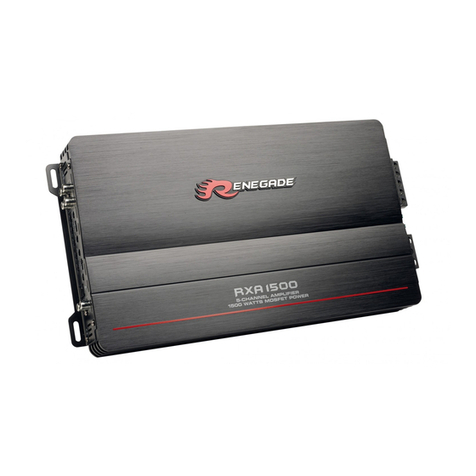
Audiodesign
Audiodesign Renegade RXA 1500 user manual
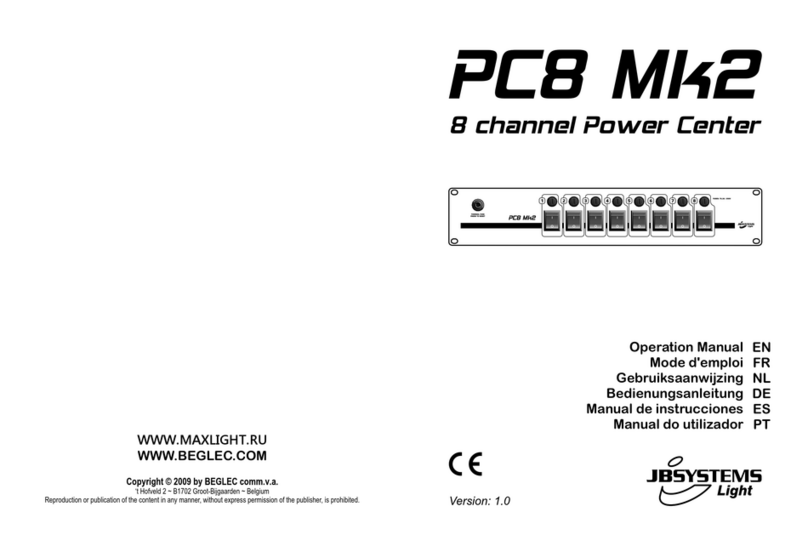
JB Systems Light
JB Systems Light PC8 Mk2 Operation manual
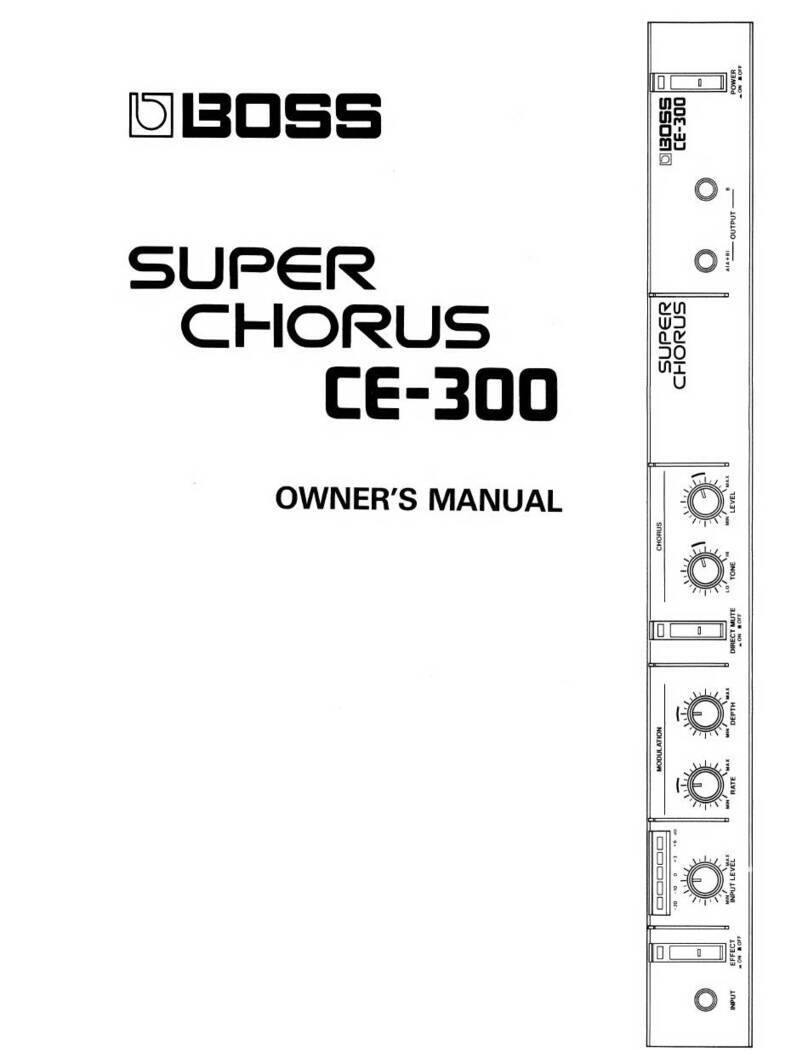
BOSSCO
BOSSCO SUPER CHORUS CE-300 owner's manual
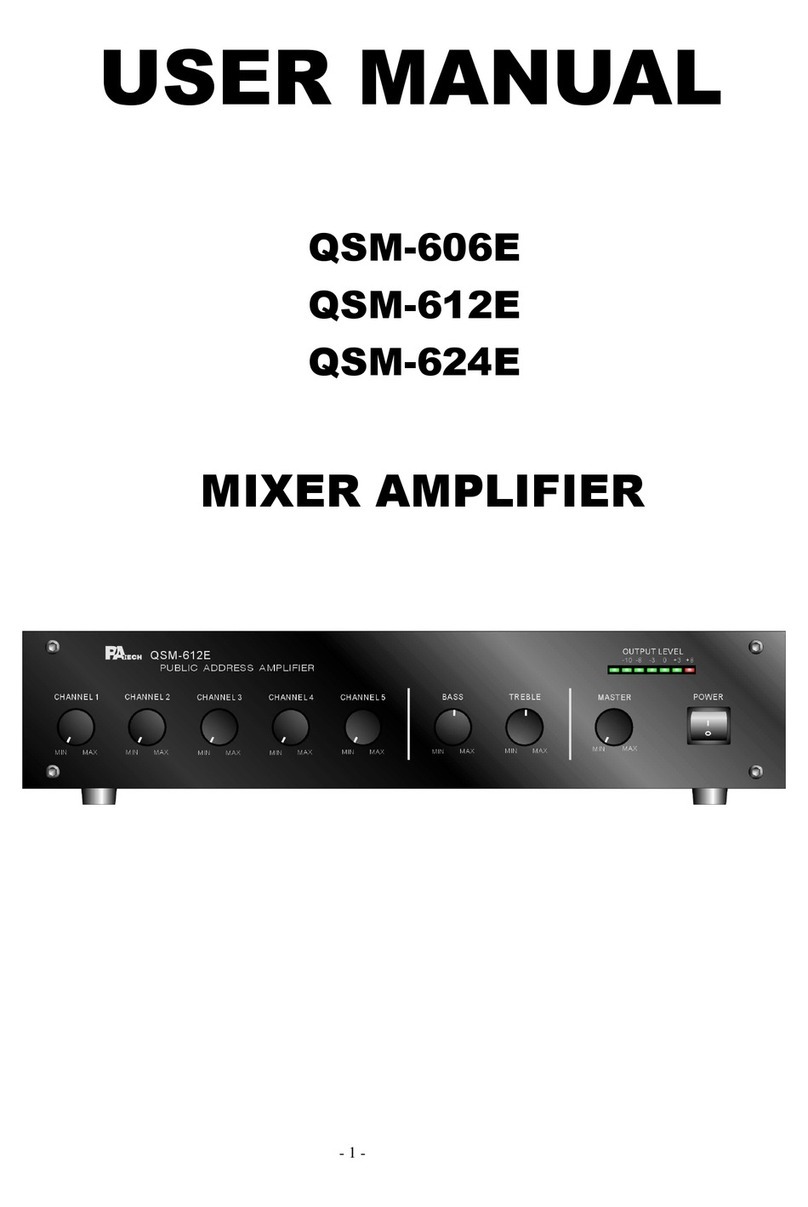
PA Tech
PA Tech QSM-606E user manual
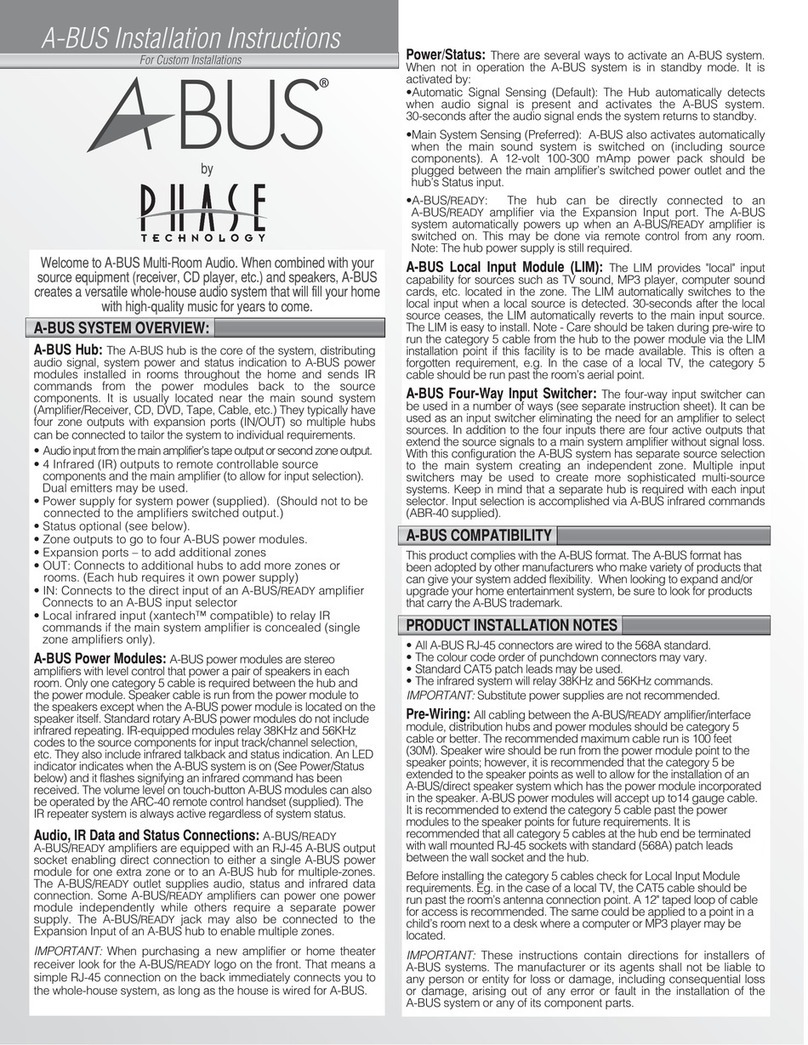
Phase Technologies
Phase Technologies A-BUS ABR-40 installation instructions


